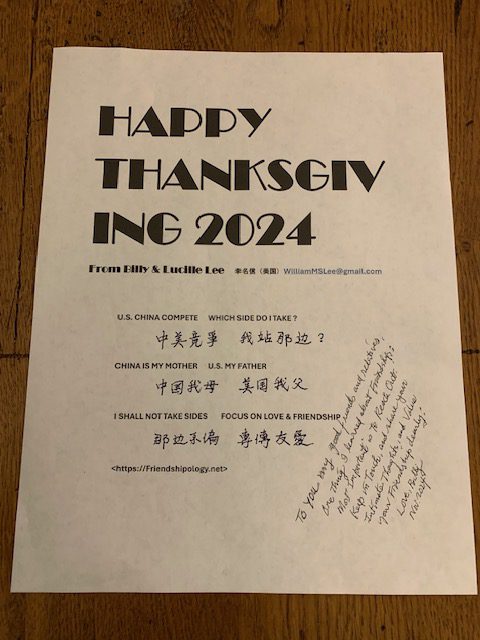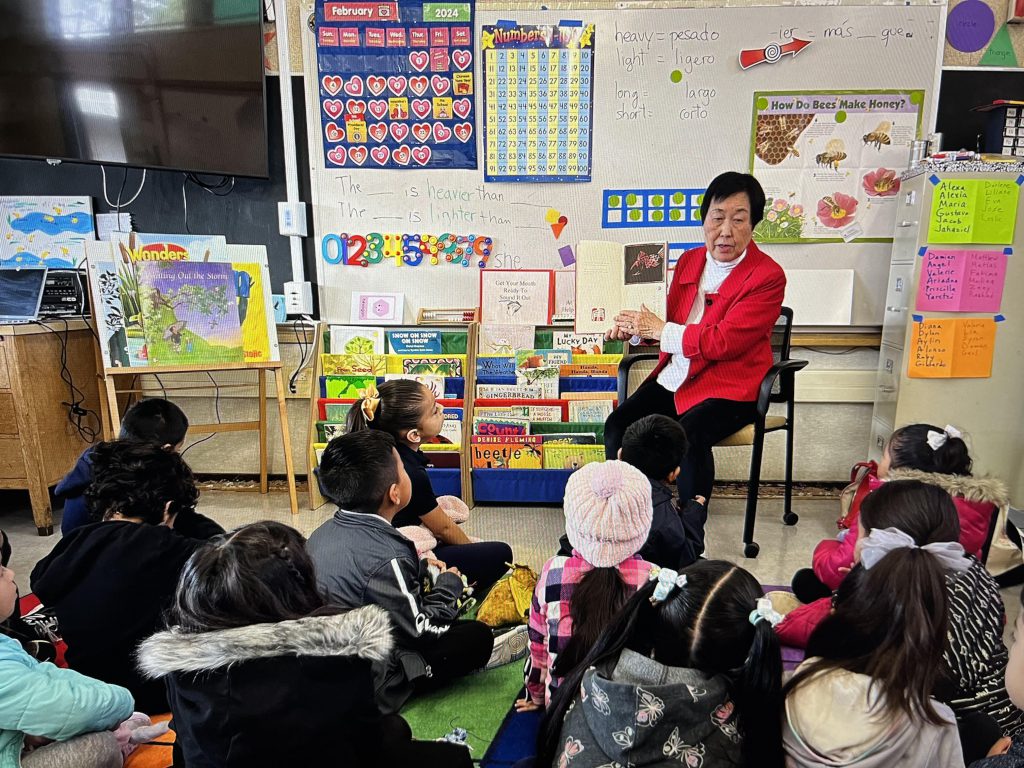从阴影走向自我:独立与完整性的旅程
by Amy Chen – September 18, 2025
Billy和我仅见过两次面,但这两次见面都恰逢我人生两个极为重要的转折点。第一次,是我大学刚毕业、第一次踏上美国土地的时候。那时,我刚参加完毕业典礼,把行李寄回家,在前往机场的路上告诉父母我要去美国。父母对这件事毫不知情,但他们也知道,我的决定无法被左右。我仿佛甩掉了父母和家乡的沉重包袱与枷锁,进入了一个崭新的世界。来到华盛顿特区后,一切都显得新鲜而陌生,我对未知充满好奇。我见过很多人,但对Billy印象深刻,虽然那时我不太记得他说过什么,但他叮嘱我要“保持个人完整性”,这句话成为我十年来心中的坚定信念。第二次见Billy,是十年后,我独立完成了学业还有职业的发展,但是内心依然活在阴影里。我渴望摆脱阴影成为独特的自己,过去一年我跟不同背景的人交流过,但我知道Billy对中美文化的深入洞察,是我最应该听的声音。所以去SF的时候,我问Billy是否可以住在他家,他毫不犹豫地答应了。
Billy and I have only met twice, but both times were at pivotal moments in my life. The first was right after college, when I set foot in the U.S. for the first time. I had just told my parents on the way to the airport that I was leaving, knowing my decision could not be changed. In Washington, D.C., everything felt unfamiliar and exciting. Out of all the people I met, Billy left a deep impression, reminding me to “maintain personal integrity”—a principle that has guided me for the past decade. The second time was ten years later. By then, I had advanced in both study and career in America, yet still struggled with an inner shadow. Over the past year I had spoken with people of different backgrounds, but I knew Billy’s cross-cultural insight was the voice I needed most. When I asked to stay at his home in San Francisco, he agreed without hesitation.
我父母是中国农村的农民,这是我的生命起点。离开农村,走进城市,进入国际大都市,这一路上我经历了极其复杂且深刻的内心挣扎。农民出身与农村身份在社会中如同污点,那种内化的羞耻感从哪里来?我试图从经济不平等、社会等级、生育政策、女性地位、文化及心理学等多个角度理解这些压力对我和类似背景群体的影响。尽管我获得了许多答案,但那些答案杂乱无章,像噪音一般,人们从各自角度定义我,而外界的期待将我逼到墙角。面对社会规则,我选择反抗,视它们为束缚的枷锁,必须打破才能前行。然而,这场自我之战持续多年,使我极度恐惧外部世界,几乎所有行动都来自于本能的自保,结果是自我枯萎、内在动力消耗殆尽。这种困境让我不得不停下来,审视究竟是什么困住了我
。My parents are farmers from a rural village in China—this is where my life began. Leaving the countryside, moving into the city, and then stepping into an international metropolis, I endured profoundly complex inner struggles along the way. Being born into a farming family and rural identity feels like a social stigma, an internalized shame whose origins I have tried to understand from economic inequality, social hierarchy, birth policies, gender status, cultural, and psychological perspectives. Though I found many answers, they were chaotic and noisy—people defining “me” from their own viewpoints while society’s expectations cornered me. Facing these social rules, I chose to rebel, seeing them as chains to be broken for freedom. Yet this battle with myself lasted years, leaving me deeply afraid of the outside world, acting mostly on instinct for self-preservation. The cost was self-decay and exhaustion of inner drive. This dilemma forced me to pause and examine what truly trapped me.
我将掌控自己的权力交给了他人,听从外界权威,用他们的视角为自己辩护。读得越多,越懂得为自己辩解,逃避责任。在过去的痛苦与不足中浸泡,我借此逃避成长的痛。最近,一位导师的猝然去世和朋友的婚礼让我深感冲突与沉重。十年来,我小心翼翼地生活,过度自保成了本能,这让我的世界越来越狭窄,逐渐听不到别人、看不到别人,内心被往昔羁绊,无法迈向充满希望的未来。我知道,我必须面对自己,直视内心,打破那层不再有用的保护壳。
I had surrendered my power to others, accepting external authorities and defending myself through their perspectives. The more I read, the better I became at justifying myself and avoiding responsibility. Immersed in past pain and shortcomings, I used this as an escape from the pain of growth. Recently, the sudden death of a mentor and a friend’s wedding filled me with deep conflict and heaviness. For ten years, I lived cautiously; overprotecting myself became instinct, narrowing my world. I gradually stopped hearing and seeing others, trapped by the past, unable to step toward a hopeful future. I realized I must confront myself, face my inner truth, and break free from this now-useless protective shell.
在我眼里,Billy是个智慧犀利且直言不讳的老人,所以我知道他肯定会让我不舒服,但我愿意接受这种审视。他说,能治愈我的是对他人真正的关心和仁慈。但我自问,我的关心是真诚的吗?还是为了避免惩罚和责备?这让我觉得自己有些虚伪。Billy也说,即使与家人产生意见和分歧,也应关心和照顾他们。我成长中见识和内化了许多暴政:因为意见不合就断绝对家人的关怀;因家人语言的否定与攻击而选择情感隔离和攻击;把自我价值的判断权交给他人而逃避自己的责任,所以我无法从别人的失败中学到经验,也难以看清和坚持自己的价值观。过去我在政治和社会议题上的辩论很活跃,但感觉很消耗精力,这场无休止的语言权力也争夺添了内心的疲惫。Billy所言不虚,家人间的分歧不应终止关心与照顾。
In my eyes, Billy is a wise, sharp, and straightforward elder, so I knew his words would likely make me uncomfortable—but I was willing to accept that scrutiny. He said that what could heal me was genuine care and compassion toward others. Yet I asked myself: is my care truly sincere, or is it just to avoid punishment and blame or approval? This made me feel somewhat hypocritical. Billy also said that even amid disagreements with family, one should still care for and look after them. Throughout my upbringing, I witnessed and internalized many forms of tyranny: cutting off family care over differences; emotional isolation and retaliation triggered by harsh family words; handing over judgment of my self-worth to others to evade personal responsibility. Because of this, I have struggled to learn from others’ failures or clearly uphold my own values. In the past, I was very active in political and social debates, but it drained my energy. This endless struggle for linguistic power added to my inner exhaustion. Billy’s words ring true: family disagreements should never end care and concern.
因为家庭冲突和语言暴力的重压,我曾选择离家出走,裹起厚厚的防护壳,最终却不断复制家庭的模式。打破这一魔咒的根本答案,在于我必须实现自我独立,从他人的视角中分离出来。Billy问我,如何看待最初带我来到美国的Chris,以及一直支持我的Miko。我知道,对他们的态度也代表了心理分离的完成度。Chris生活在其父亲的光环阴影中,现实中无力实现自我;他塑造了我作为革命青年身份的宏大叙事。Miko早已脱离传统的家庭角色,构建了基于信念和使命的多元社区网络。处于这两种影响之间,我如同迷失在迷宫中,但深知需认清他们对我的影响,并自觉完成从他们阴影中的独立。
Under the heavy pressure of family conflicts and verbal abuse, I once chose to run away from home and wrapped myself in a thick protective shell, only to keep repeating the family patterns. The key to breaking this cycle lies in achieving true independence—separating myself from others’ perspectives. Billy asked me how I viewed Chris, who first brought me to the U.S., and Miko, who has always supported me. I understood that my attitude toward them reflected how fully I had psychologically separated myself. Chris lives under the shadow of his father’s legacy, unable to realize his own identity, and he shaped my grand narrative as a revolutionary youth. Miko has long broken away from traditional family roles and built a diverse community based on belief and mission. Caught between their influences, I felt lost in a maze but knew I must recognize their impact and consciously complete my independence from their shadows.
Billy没有给我明确答案,但提出了关键问题:“谁是你的女性偶像?”这是关乎是否能成为独立而真实自我的核心问题。这个自我不再依赖过去,而由每日行为塑造。临别之际,我用简单艺术创作——水果拼盘,赋予早餐独特的意义,创造属于我们的回忆,而非迎合Billy的期待。临走前,Billy一再叮嘱我:找到属于自己的价值观,保持个人完整性。他说,未来世界充满不确定与动荡,我必须稳固自己,才能不被动摇。身处水中,要学会游泳;身处空中,要学会飞翔
。Billy did not give me a clear answer but posed a crucial question: “Who is your female idol?” This question strikes at the heart of whether I can become an independent and authentic self—one no longer reliant on the past but shaped by daily actions. Before parting, I created a simple piece of art—a fruit platter—imbuing breakfast with unique meaning and making memories that belonged to us, rather than conforming to Billy’s expectations. He repeatedly urged me to find my own values and maintain personal integrity. He said that the future world would be full of uncertainty and turmoil, and I must solidify myself to remain unshaken. Like being in water, I must learn to swim; in the air, I must learn to fly.
他还告诉我,人们对艺术品的欣赏,最初是基于印象,随着靠近,最初印象会因色彩和形态的细节而改变。如果觉得不重要,人们就会转向别处。提升影响力的关键,在于“留白”,为他人留出思考空间,使他们真正欣赏所呈现的内容。无需全盘托出,而是通过提问激发对方思考。这正是Billy对话的策略:不加批评和强加建议,却帮助我看清突破口和方向。
He also told me that people’s appreciation of art begins with an initial impression, which changes as they get closer, noticing details in color and form. If something feels unimportant, they simply look away. The key to increasing impact lies in “leaving space”—allowing others room to think and truly appreciate what is presented. It’s not about revealing everything but stimulating thought through questions. This is exactly Billy’s approach in conversation: offering no criticism or imposed advice, yet helping me clearly see my breakthroughs and direction.
这段经历,对于我而言,是一次自我独立的宣言。过去那些压在身上的枷锁,是我为获得归属和认可而交出的部分自我。那些被灌输的角色和身份,是困住我的链条。从封闭走向开放,我学会接纳脆弱与不完美,承认伤痛而不被其定义。开放的心态让我重新连接他人,也让他人得以靠近我。对他人关心和仁慈,不再是出于恐惧或期待回报,而是真实内心的呼唤。这种转变给予我新的力量——对自我的责任感与与世界的温暖连接。我对人的理解,也由原先带有分析和理性的科学视角,开始向艺术的欣赏转变,学会尊重未知的留白。这份认知转变深刻影响我,让我看到力量在自己手中,我的自我由想法和选择塑造。不论是Chris、Miko,还是Billy,他们都是我生命中的引路人,我接受他们的影响,也选择塑造自己想成为的样子。
This experience marked a declaration of my self-independence. The burdens that once weighed on me were parts of myself I had surrendered for belonging and acceptance. The roles and identities imposed on me were chains that trapped me. Moving from closedness to openness, I learned to embrace vulnerability and imperfection, acknowledging pain without letting it define me. This open mindset allowed me to reconnect with others and let them come closer. Caring for others with kindness came no longer from fear or expectation but from a genuine inner call. This transformation gave me new strength—a sense of responsibility for myself and a warm connection to the world. My understanding of people shifted from an analytical, rational scientific view to an appreciation akin to art, learning to respect the unknown spaces left open. This shift profoundly changed me, showing that power lies within myself, and my identity is shaped by thoughts, choices and actions. Whether Chris, Miko, or Billy, they have all been guides in my life. I accept their influence while choosing who I want to become.
______________________________________________________________________________







